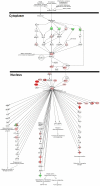Discovery of molecular mechanisms of traditional Chinese medicinal formula Si-Wu-Tang using gene expression microarray and connectivity map
- PMID: 21464939
- PMCID: PMC3065471
- DOI: 10.1371/journal.pone.0018278
Discovery of molecular mechanisms of traditional Chinese medicinal formula Si-Wu-Tang using gene expression microarray and connectivity map
Abstract
To pursue a systematic approach to discovery of mechanisms of action of traditional Chinese medicine (TCM), we used microarrays, bioinformatics and the "Connectivity Map" (CMAP) to examine TCM-induced changes in gene expression. We demonstrated that this approach can be used to elucidate new molecular targets using a model TCM herbal formula Si-Wu-Tang (SWT) which is widely used for women's health. The human breast cancer MCF-7 cells treated with 0.1 µM estradiol or 2.56 mg/ml of SWT showed dramatic gene expression changes, while no significant change was detected for ferulic acid, a known bioactive compound of SWT. Pathway analysis using differentially expressed genes related to the treatment effect identified that expression of genes in the nuclear factor erythroid 2-related factor 2 (Nrf2) cytoprotective pathway was most significantly affected by SWT, but not by estradiol or ferulic acid. The Nrf2-regulated genes HMOX1, GCLC, GCLM, SLC7A11 and NQO1 were upregulated by SWT in a dose-dependent manner, which was validated by real-time RT-PCR. Consistently, treatment with SWT and its four herbal ingredients resulted in an increased antioxidant response element (ARE)-luciferase reporter activity in MCF-7 and HEK293 cells. Furthermore, the gene expression profile of differentially expressed genes related to SWT treatment was used to compare with those of 1,309 compounds in the CMAP database. The CMAP profiles of estradiol-treated MCF-7 cells showed an excellent match with SWT treatment, consistent with SWT's widely claimed use for women's diseases and indicating a phytoestrogenic effect. The CMAP profiles of chemopreventive agents withaferin A and resveratrol also showed high similarity to the profiles of SWT. This study identified SWT as an Nrf2 activator and phytoestrogen, suggesting its use as a nontoxic chemopreventive agent, and demonstrated the feasibility of combining microarray gene expression profiling with CMAP mining to discover mechanisms of actions and to identify new health benefits of TCMs.
Conflict of interest statement
Figures





References
-
- Efferth T, Li PC, Konkimalla VS, Kaina B. From traditional Chinese medicine to rational cancer therapy. Trends Mol Med. 2007;13:353–361. - PubMed
-
- Chow MS, Huang Y. Utilizing chinese medicine to improve cancer therapy - fiction or reality? Curr Drug Discov Technol. 2010;7:1. - PubMed
-
- Kang JX, Liu J, Wang J, He C, Li FP. The extract of huanglian, a medicinal herb, induces cell growth arrest and apoptosis by upregulation of interferon-beta and TNF-alpha in human breast cancer cells. Carcinogenesis. 2005;26:1934–1939. - PubMed
Publication types
MeSH terms
Substances
LinkOut - more resources
Full Text Sources
Other Literature Sources
Molecular Biology Databases
Research Materials
Miscellaneous

